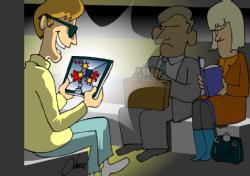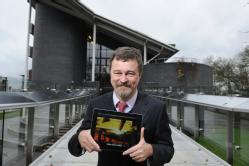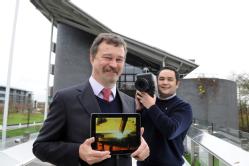Maths helps mobiles & tablets match eyes’ ability to switch from sunshine to shadow
 Researchers have pushed the boundaries of High Dynamic Range (HDR) video to match our own eyes’ ability to cope with the real world's ever rapidly changing light intensity - such as sun simply going behind clouds. Now researchers at WMG at the University of Warwick, have found a way to compress and stream HDR video directly to monitors and mobile devices, such as an iPad, bringing enormous benefits to industries including gaming and security.
Researchers have pushed the boundaries of High Dynamic Range (HDR) video to match our own eyes’ ability to cope with the real world's ever rapidly changing light intensity - such as sun simply going behind clouds. Now researchers at WMG at the University of Warwick, have found a way to compress and stream HDR video directly to monitors and mobile devices, such as an iPad, bringing enormous benefits to industries including gaming and security.
Researchers at WMG at the University of Warwick, working in partnership with spinout company goHDR Ltd, have succeeded in achieving and patenting a method of real-time encoding and remote display of High Dynamic Range (HDR) video. Working with their Portuguese partner INESC Tec, they have also been able to demonstrate the technique in action on an iPad. This means that full HDR video content can now be encoded and streamed directly to remote displays, including mobile devices, or sent for storage back at home-base. Gaming will be transformed too, with HDR content being directly available for interactive online and cloud-based games.
HDR imagery delivers the wide range of light intensity levels found in real scenes ranging from direct sunlight to details of dark shade. HDR video thus offers “True Brightness”; a significantly enhanced viewing experience. The amount of data required to capture all this extra detail, however, is huge, with high definition True Brightness footage generating the equivalent of a CD worth of data every second. goHDR has a patented algorithm that is capable of compressing HDR frames by at least 150:1 with minimal perceptual loss of quality. The partners have now developed a new method that enables uncompressed HDR frames to be encoded and streamed to a remote device in real-time. Encoding rates of over 60 frames per second (fps) have been achieved for 720p resolution on a modern 16-core computer.

 Professor Alan Chalmers, Professor of Visualisation at WMG, University of Warwick and Founder and Innovation Director of goHDR, said:
Professor Alan Chalmers, Professor of Visualisation at WMG, University of Warwick and Founder and Innovation Director of goHDR, said:
“This project has brought together worldwide expertise in HDR imaging from the University of Warwick and INESC Tec with the innovation and patented HDR video compression technology of goHDR. Together the partners have clearly demonstrated the technical feasibility of encoding and streaming HDR video content to mobile devices in real-time.”
“Previously HDR video compression had to be done off-line. This meant the HDR video data from a camera had to be first stored on special high-speed disks, encoded and finally transmitted. This could take many minutes, precluding any live broadcasts. Real-time encoding now opens up many more opportunities for people to experience HDR content directly. For example:
- In games, it allows full HDR game content to be delivered, even to a player of interactive games, from the cloud. Most video games are generated in HDR but until now, a data transmission bottleneck has prevented this extra realism from being delivered to the user.
- In security, it enables surveillance cameras to deliver live HDR feeds, immediately providing all the details within a scene, even in extreme lighting conditions
- In leisure, it allows streaming HDR content from a consumer camera, for example when snowboarding down a mountain, to your friends watching on their tablets back at home.
 Professor Chalmers added: “Our work opens up the real-time delivery of HDR video to a wide range of devices. We expect in the future it will even be possible, with real-time encoding, to capture and stream HDR video from mobile devices.”
Professor Chalmers added: “Our work opens up the real-time delivery of HDR video to a wide range of devices. We expect in the future it will even be possible, with real-time encoding, to capture and stream HDR video from mobile devices.”
Dr Maximino Bessa, lead researcher of the project at INESC Tec said: “Mobile devices are rapidly becoming the main means for viewing content and playing games. Delivering HDR video to a tablet brings about a step change in viewing experience for mobile devices.”
For more information please contact:
Professor Alan Chalmers, WMG, University of Warwick
Innovation Director, goHDR Ltd.
Tel: +44 (0)2476 522102
Email: Alan.Chalmers@gohdr.com
Peter Dunn, email: p.j.dunn@warwick.ac.uk
Head of Communications, Communications Office, University of Warwick,
Tel: +44(0)24 76 523708 Mobile/Cell +44(0)7767 655860
Dr Maximino Bessa, INESC Tec, Portugal
Tel: +351 (0) 259350324
Email: maxbessa at utad dot pt
Notes for Editors:
goHDR (www.gohdr.com) provides advanced data compression algorithms to customers developing HDR technology. The encoding/decoding software developed by goHDR enables the adoption of HDR video across many sectors, including film and television, computer games, security and mobile devices.
INESC TEC is the name of the Associate Laboratory coordinated by INESC Porto, a private non-profit association with over 25 years of experience in R&D and technology transfer. INESC TEC incorporates 12 Units with complementary competences, always looking to the international market. At INESC TEC, the knowledge and results generated as part of fundamental research are typically applied in technology transfer projects, always guaranteeing added and immediate social relevance. With the recent launching of INESC P&D BRASIL (in São Paulo, Brazil), INESC TEC has strengthened its presence worldwide, always associating Portugal to international scientific excellence.
PR210 29th November 2012
